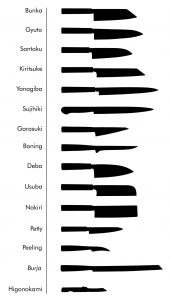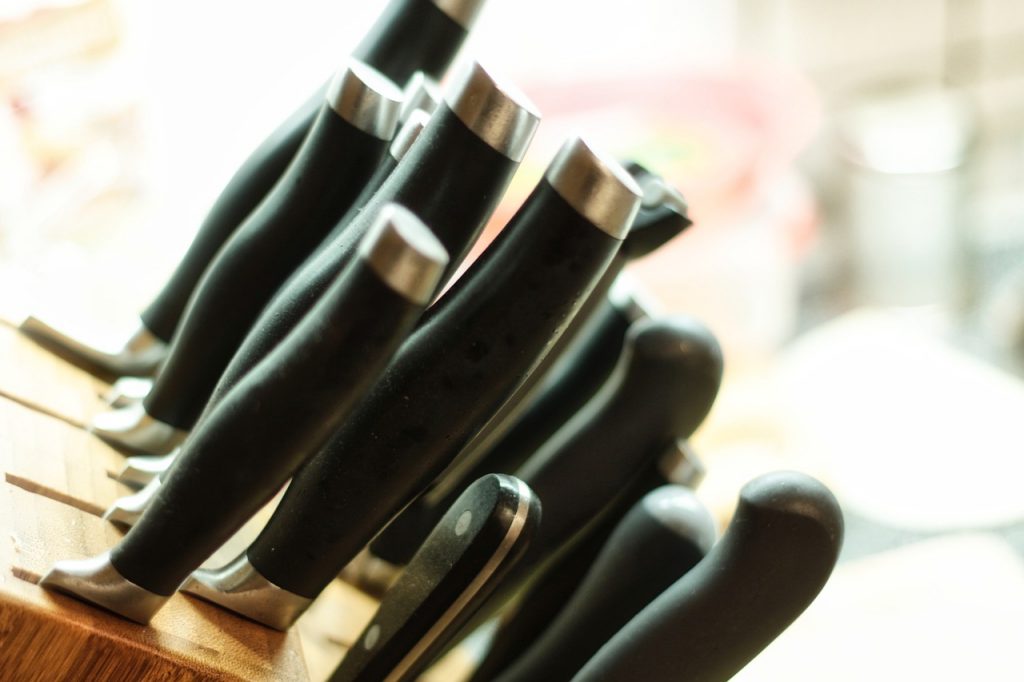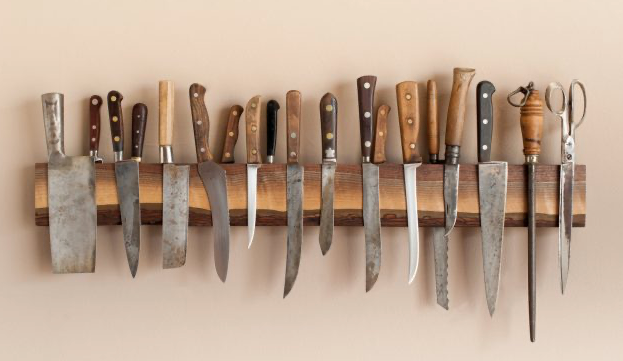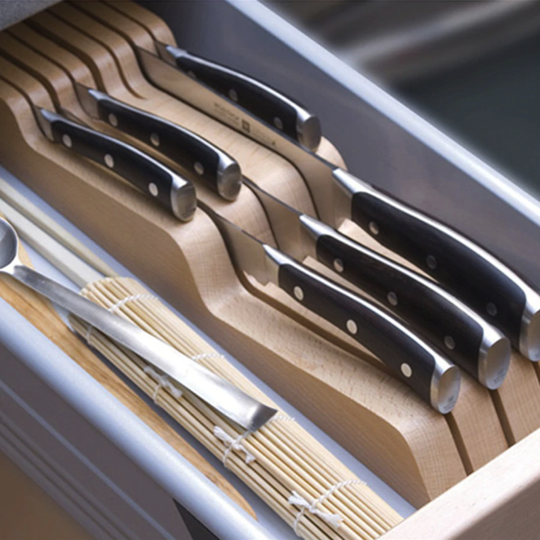If you are a fan of Japanese knives, you know that they are some of the best in the world. In addition, they are not only sharp and precise, but also they have a unique style that is excellent than other knives. If you want to keep your knives in excellent condition, it is essential to store them properly. This blog post will discuss how to store Japanese knives to stay sharp and look great for many years!
What Makes Japanese Knives Popular?

So, what makes a Japanese knife so special? Japan has a long history of crafting high-quality knives, and the country takes great pride in its knife-making tradition. Moreover, Japanese knives are typically made from harder steel than their Western counterparts. It means that they can hold an edge for longer and are less likely to chip or break.
If you love cooking or are a professional chef, you know that having a great knife can make all the difference in the world. So, what are the features of Japanese knives that make them so popular?
🔪Sharpness
Japanese knives are renowned for their sharpness. If you’ve ever used a Japanese knife, you know that they can make quick work of any ingredient, no matter how tough it is. You can easily cut through thick slices of meat or chop vegetables with precision and ease.
🔪 Style
Japanese knives also have a unique style and are typically light and thin, making them easy to handle. Also, their simple design makes them a popular choice for professional chefs and home cooks alike.
🔪 Quality
When it comes to quality, Japanese knives are hard to beat. Also, they are made from high-quality materials and are built to last. If you take care of your knives, they will serve you well for many years.
🔪 Ease of Maintenance
Another feature that makes Japanese knives so popular is their ease of maintenance. Unlike some Western knives, they do not require care and upkeep to stay sharp. All you need to do is keep them clean and dry after use, and you will be good to go.
🔪 Ease of Resharpening
If your Japanese knife does become dull, it is easy to sharpen it back to its original state. All you need is a sharpening stone and some water, and you will be able to get your knife razor-sharp in no time.
As you can see, there are many reasons why Japanese knives are so popular. If you are thinking about purchasing a knife and consider a Japanese knife. You won’t be disappointed!
Types of Japanese Knife

Kitchen knives in the Japanese style are made from basic to hefty blades with a wide range of purposes. You can find a Japanese knife to tackle any kitchen task, including slicing, dicing, chopping vegetables; mincing herbs; filleting fish; removing bones from meat, and bread and pastry work.
Moreover, Japanese knives come in both Western-style and traditional shapes, and the most common types of Japanese kitchen knives are:
❕Bunka ( Multi-Purpose )
The Bunka is a versatile all-purpose knife in Western cuisine, and that is perfect for slicing and dicing vegetables and fruit. It can able to cut through various materials and has a contoured, low-profile body. It contains a micro-serrated blade designed for precise work with food and an ergonomic handle for easy grip and control.
❕Gyuto (Chef’s Knife)
The Gyuto is a chef’s knife used for various tasks, including slicing, dicing, chopping vegetables; mincing herbs; filleting fish; removing bones from meat, and bread and pastry work. It is a versatile all-purpose knife in Western cuisine.
The Japanese version of the knife is frequently made of double-bevel and harder steel. Thus, it is also lighter and thinner than a Western-style chef’s knife, making it easier to handle. The Gyuto has a long, curved blade that allows the cook to rock the knife on the cutting board for more precise cuts.
❕Deba (Butcher Knife)
A classic, heavy-duty Japanese butcher knife specially designed for breaking down large cuts of meat into smaller pieces. Also, it has a thick, single-bevel blade that is perfect for cutting through bone and other tough materials. In addition, the Deba is also great for slicing fish and seafood and comes in a variety of forms, including:
- Miroshi-deba: It’s for filleting fish (“miroshi” in Japanese means “fillet”). These sorts of deba knives are longer and thinner than other deba knives.
- Yo-deba: It is a European-style knife with an unusual handle. The yo-deba is for slicing meat.
- Kanisaki-deba: It’s a deba that’s been specially sharpened to cut lobsters and crabs.
- Ko-deba: It’s a small deba, ideal for little fish.
- Hon-deba: a real deba with the biggest and thickest of all deba.
❕Santoku (Multi-Purpose)
The Santoku, which means a knife of three virtues, is a Japanese all-purpose knife quickly becoming popular in the West. The knife’s handle might be European or Japanese, but the blade is typically a double-bevel design. The Santoku is a great general-purpose knife for meat, fish, and vegetables.
❕Usuba & Nakiri (Vegetable Knife)
These are traditional Japanese vegetable knives with rectangular blades. Nakiri means “vegetable knife,” and Usuba means “thin knife.” Both knives are for chopping vegetables, but the Usuba is thinner and sharper, making it better suited for precision work. The Nakiri is an excellent choice for home cooks who want a durable, easy-to-use vegetable knife.
❕Petty (Utility/Paring Knife)
It is a tiny version of the Gyuto (Chef’s knife); a putty knife is for all sorts of specific activities that would be difficult with a bigger knife. It could include peeling and slicing fruit, coring tomatoes, or deveining shrimp. The Petty knife is also great for detailed work in the kitchen, such as making garnishes or decorations.
❕Yanagiba
Yes, it is for cutting sushi! It is a thin and long blade used for cutting slim slices of raw fish. The Yanagiba is a single-bevel knife, which means that the only sharp part is one side of the blade. This makes it easier to achieve a very sharp and precise edge. The Yanagiba is also great for slicing meat, making it a versatile all-purpose knife.
These are the most common types of Japanese knives. There are many other varieties, including specialty knives designed for cutting specific foods. But, these five knives should be enough to start your Japanese knife collection!
How to Store Japanese Knives

When it comes to accurate cutting, keeping your Japanese knife in good working order and cleaning it is as crucial as proper storage. Investing in a high-quality Japanese knife necessitates a corresponding amount of money into appropriate storage to keep the blade secure and safe when not in use.
Careless storage can damage and blunt the delicate edge of a Japanese knife, so be sure to protect them adequately. So, how to store a Japanese knife? Here are some tips on how to store your Japanese knives.
🗸Knife Blocks

The most popular way to store knives is in a knife block. It is a wooden or plastic block with slots to insert your knives into. Knife blocks are not only small and light, but they are also flexible, you can move them around easily. You may put them on any work surface since they are so compact. They are functional, straightforward, and you can place them near your workstation for easy and quick use.
The main downside is that knife blocks can be difficult to clean. The slots can trap gunk and bacteria, so you will have to take the time to clean it regularly. In addition, if your knives are not all the same size as the slots in the block, they might damage or dull over time.
‼️Storage Tip: To secure the cutting edge, the blade’s blunt side must be placed towards the block. It’s also critical to keep the blade from scraping against the block while removing it.
In general, knife blocks are an efficient and simple way to keep knives. If you’re thinking about buying knife blocks, it’s an excellent option.
🗸Knife Racks

Another common way to store your knives is on a knife rack. These racks allow you to arrange your workspace attractively and efficiently. It is designed to fit without gaps, making them ideal for adding a touch of class to your kitchen. They also offer an excellent way to display your favorite cutlery.
Knife racks can be placed on the wall or countertop and are easily accessible. They come in various materials, such as bamboo, steel, or plastic. You can also find knife racks that accommodate different-sized knives.
‼️Storage Tip: To avoid damaging the knife and protect it, place your knife on a rack in this manner: The blade’s spine should be placed against the rack first, then gently roll the blade sideways. This makes it far more chance for the knife-edge to chip against the rack, ensuring that your knives stay sharp.
A knife rack is a great way to store your knives if you want to show them off or keep them within easy reach.
🗸Knife Drawer

If you’re not using your knives daily, storing them in knife drawers is an excellent way to protect the blade. A knife drawer is a concealed, sleek, and importantly, safe place to store knives. If you have enough space, they’re an excellent choice.
A slotted knife drawer prevents jostling if you have a collection of knives since each has its slot. Knife drawers can keep up to seven knives or more, which is enough for your kitchen at home. They’re also relatively inexpensive. The only downside is that they can be difficult to access if you want to use your knives frequently.
‼️Storage Tip: If you have a slotted knife drawer, make sure the slots are slightly larger than your knife’s blade. It will allow you to insert and remove the blade without damaging it. When utilizing knife drawers, it is also recommended to invest in a saya for your Japanese knife, as it adds further protection.
Knife drawers are a safe and affordable way to store your knives. It’s an excellent option if you’re not using them on a daily basis.
These are the three most common ways to store your Japanese knives. Whichever way you choose, make sure you follow the proper storage guidelines to protect your blade.
Tips on How to Take Care of Your Japanese Knives

You should also give serious thought to your knife’s maintenance. A little bit of effort now can keep your knives razor-sharp and functioning properly for many years. Aside from getting proper storage for your Japanese knives, you can do a few other things to take care of them. Here are some tips:
➨Avoid Using a Knife Sharpener
Many people think that they need to sharpen their knives every time they use them. However, this is not the case. Using a knife sharpener can damage your blade. If you must sharpen your knife, it’s best to take it to a professional, especially with Japanese knives.
➨Wash Your Knife by Hand
It’s important to wash your knife by hand, using warm water and soap. Do not put your knife in the dishwasher, as this can damage the blade. If you must wash it in the sink, be sure to use a soft sponge or cloth not to scratch the blade.
➨Do Not Let Your Knife Soak in Water
You should also avoid letting your knife soak in water for too long. It can cause the blade to rust. If you need to wash it in the sink, be sure to dry it off immediately afterward.
➨Use a Cutting Board
When using your knife, be sure to use a cutting board. It will protect your countertops from getting scratched as well as your knife from getting dull. It’s also a good idea to use a softer cutting board, such as bamboo or plastic.
➨Avoid Using Your Knife on Non-Food Items
It’s important to only use your knife on food items. Do not use it to open cans or bottles since it can damage the blade.
➨Use a Honing Rod
A honing rod is a tool that helps to keep your knife sharp. It’s a good idea to use it at least once a week or whenever you feel like your knife is starting to get dull.
➨Store Your Knife in a Safe Place
Last but not least, always store your knife in a safe place. It means keeping it out of the reach of children and away from sharp objects.
Following these simple tips will help keep your Japanese knives in top condition so you can enjoy them for many years!
Final Thoughts
When it comes to storing your Japanese knives, there are a few different options to choose from. The most important thing is that you find a safe and secure place for them, so they’re not constantly getting damaged. Be sure to also take care of your knives by following the proper maintenance guidelines. With a little bit of effort, your knives will remain razor-sharp and look great!
Do you have any tips on storing or taking care of Japanese knives? Share them with us in the comments below!
